If there is one thing that people associate with Andhra Pradesh, it is this simply awesome mango pickle called Avakai or Avakaya. Omnipresent in most Andhra households, there are several variations of Avakaya; like this traditional, regular Avakai, Bellam Avakai (with Jaggery), Endu Avakai (when pieces have been sundried), with Garlic, with Senagalu/Chana. Needless to say, Avakai in all its forms is delicious. 🙂
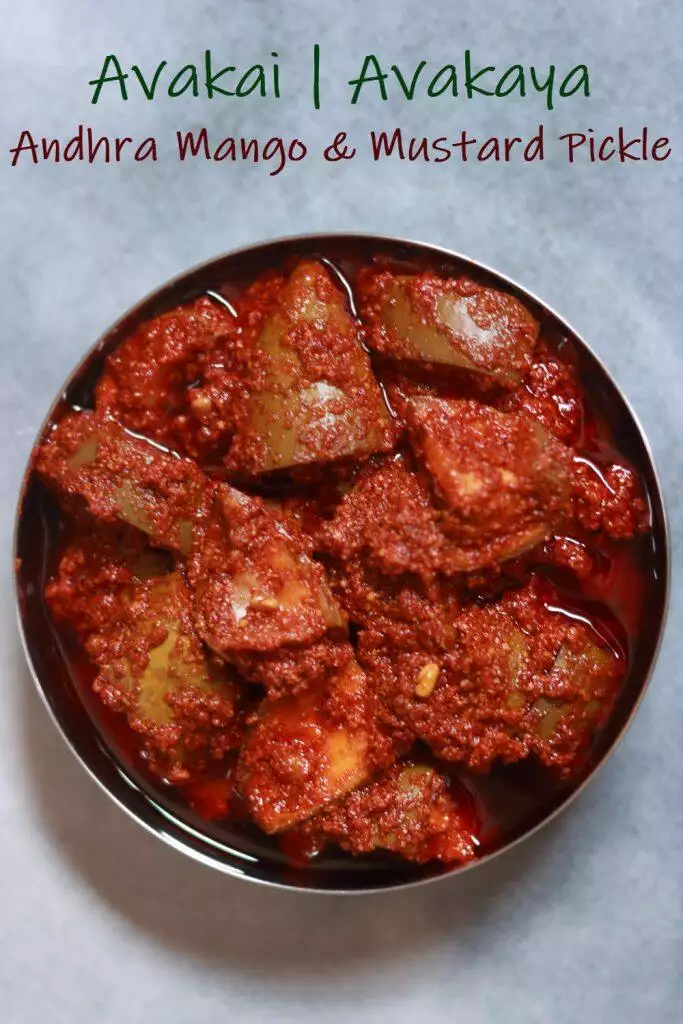
Ava-kai literally means raw fruit (kai) with mustard (ava), so the stars of this recipe are the raw mango and the mustard powder.
Every summer, pickle lovers from Andhra and Telangana wait for Kotta Avakai or freshly made Avakai. Kotta Avakai Ruchi or the taste of fresh Avakai is what summer is all about. The best way to enjoy this delectable mango pickle is to mix it with steaming hot rice and ghee, and then savour it one mouthful at a time. That is it. Heaven on earth! 🙂
Of course, we also enjoy Avakai with Curd Rice, Dal Rice. In addition, we make Avakai Perugu Pachadi (Avakai mixed with yogurt) and then enjoyed with dosa and idli.
This recipe was first posted in 2017 and has been updated several times since. I have again updated it with more tips. Do not let the tips intimidate you. It is just my attempt to pass on all the knowledge I inherited from my Mom and Grandmother.
My Mother and Grandmother’s Tips for Making the Perfect Avakai
- Choosing the perfect mangoes
The Avakai mangoes should:- be dark green, firm and not have a hard seed.
- be tangy/sour.
- not be juicy as the the pickle will spoil quickly.
- If you get juicy mangoes, dry the pieces for 3 to 4 hours under hot sun.
- Chopping the mangoes
- Since you need a heavy duty chopper to cut through the mango seed, I get my mangoes chopped from the person I buy them from; this service is available in most Indian markets that sell mangoes for pickles.
- Ensure that the mango pieces are chopped such that each piece has a part of the kernel. If you use pieces without the kernel, the Avakai will not preserve well.

- Check each piece of mango to ensure that it has the kernel. You can set aside pieces without the kernel and make temporary Avakai.
- Ensuring everything is bone dry
- Every vessel & utensil you use to make the Avakai as well the bottle in which you store it and the space in which you make it should be bone dry.
- Storing the Avakaya
- Store the Avakaya in an airtight ceramic or glass bottle.
- Do not open the bottle in which the Avakaya is stored very often. For everyday use, transfer some pickle into a separate bottle.
- Avoid opening the main bottle during monsoon or in humid atmosphere.
- About the Ingredients
- For the best taste, grind mustard seeds just before making the pickle, though you could use readymade mustard powder as well.
- Use unrefined, cold-pressed Sesame Oil (Til oil) because it adds a depth of flavour to the Avakai.
I will now stop with my do’s and dont’s. 🙂 Believe you me, all the care will be worth the effort.
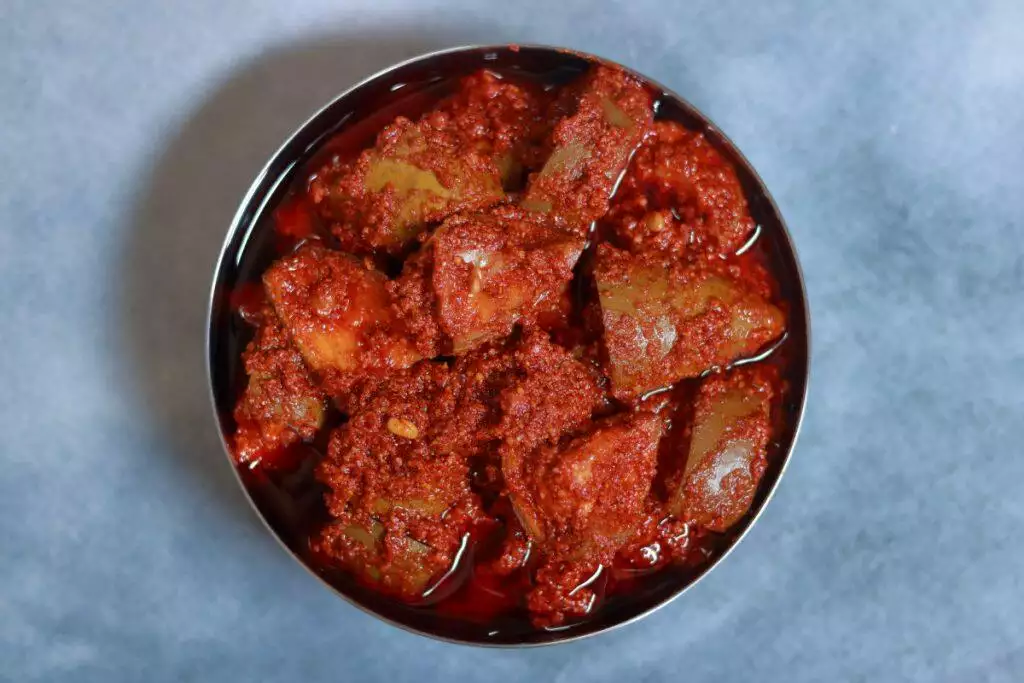
Recipe for Some More Andhra Mango Pickles
Here are recipes for two more Andhra mango pickles that have a long-shelf life of a year or more:
- Maagai | Magai | Magaya: Andhra Dried Mango Pickle
- Mamidikaya Turumu Nilava Pachadi | Andhra Mango Thokku | Grated Mango Pickle
Recipe for Some Instant Mango Pickles
While you are waiting for the Avakai to pickle properly, do try my recipes for:
How to Make Avakai or Avakaya
- Getting the Jar/Bottle Ready for Storage
- Wash and completely dry ceramic or glass jar of 4 kg or 4 litre capacity.
- Getting the Oil Ready
- Heat 1.25 litres of Sesame oil and then let it cool completely to room temperature. Do this about 2 hours before you start making the pickle. This ensures that the oil cools to room temperature by the time you add it to the pickle. If the oil is even a bit warm, the resulting condensation will spoil the pickle.
- Getting the Mango Pieces Ready
- Clean each piece of mango with a clean, dry, soft cotton cloth.
- Discard all the seeds, even the bits that remain attached to the mango pieces.
- Examine each piece carefully to ensure that it is just perfect. Kernel intact, no holes, no sign of ripeness, etc.
- Now, spread the mango pieces on a dry cloth or paper for about 15 minutes to air-dry. You can also dry them under the sun.

- Clean each piece of mango with a clean, dry, soft cotton cloth.
- Getting the Mustard Powder Ready
- Grind 300 gms mustard seeds to a coarse powder.
- Making the Avakaya | Avakai
- In a large and absolutely dry vessel, mix the mustard powder, 300 gms spicy red chilli powder, 175 gms salt, 2 tbsp fenugreek seeds, and 50 gms bengal gram (kala chana) and/or 50 gms peeled garlic cloves..

- Using a dry spatula, mix all the spices well.
- Now, add the mango pieces to this dry spice mix and mix well.

- Next, gradually add 1/2 the sesame oil to the mango-spice mix.
- With an absolutely dry spatula, mix well till all the mango pieces are covered with the masala and the oil.

- Transfer the Mango Pickle to a bone dry, air-tight bottle/jar and pour the remaining oil onto the pickle.

- Seal the bottle completely.
- Store the jar in a dry location for at least 2 weeks.
- Mix the Avakai with a gentle hand and an absolutely dry spatula once in 2 or 3 days.
- Top with some more sesame oil, if required.
- In a large and absolutely dry vessel, mix the mustard powder, 300 gms spicy red chilli powder, 175 gms salt, 2 tbsp fenugreek seeds, and 50 gms bengal gram (kala chana) and/or 50 gms peeled garlic cloves..
- Using the Avakai
- Using a dry spatula, transfer the required amount of Avakai to a smaller bottle.
- Use the Avakai from this bottle.
- Serve Avakai with hot rice and ghee, or as a side to Curd Rice.
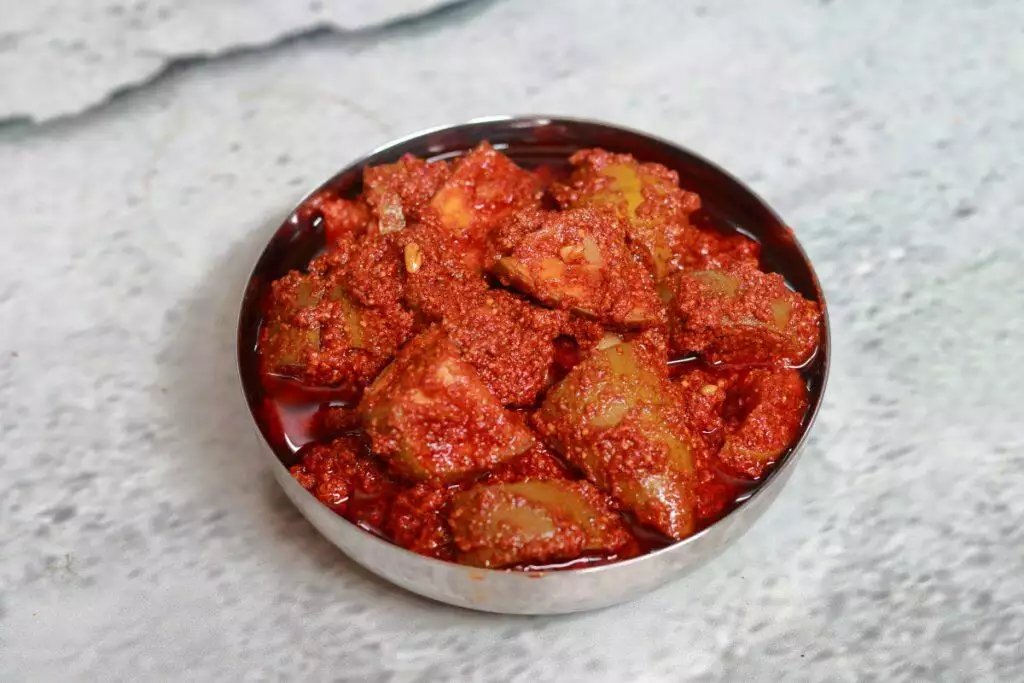
Recipe for Avakai: The Andhra Mango Pickle
Avakai | Avakaya: The Andhra Mango Pickle
Equipment
- Ceramic or Glass Jar with a Tight-fitting Lid of 4 kg
- Mixer-Grinder
- Spatula
- Large Vessel of 4 kg capacity
Ingredients
- 2 kgs Mango (Raw Mango Cut to pieces as described in the Notes below)
- 300 gms Mustard Seeds
- 300 gms Spicy Red Chilli Powder
- 175 gms Salt
- 2 tbsp Fenugreek Seeds
- 1.25 litres Sesame Oil (Cold-pressed oil preferred; Called Chekka Nuvvula Nune in Telugu)
- 50 gms Whole Bengal Gram (optional)
- 50 gms Garlic Cloves (optional)
Instructions
- Wash and completely dry ceramic or glass jar of 4 kg or 4 litre capacity. Note: The jar must be bone dry so we normally sun-dry it for a couple of days.
- Heat 1.25 litres of sesame oil and then let it cool completely to room temperature. Note: Once again, we do this about 2 hours before we start making the pickle to ensure that the oil is cold when we add it to the pickle. If the oil is warm, then condensation will form when you add it to the pickle and the pickle will spoil.
- Clean each piece of mango with a clean, dry, soft cotton cloth.
- Spread the mango pieces on a dry cloth or paper for about 15 minutes to air-dry. Note: You can also dry them under the sun.
- Grind 300 gms of mustard seeds to a coarse powder.
- In a large and absolutely dry vessel, mix the mustard powder, 300 gms spicy red chilli powder, 175 gms salt, 2 tbsp fenugreek seeds, and 50 gms bengal gram (kala chana) and/or 50 gms peeled garlic cloves.
- Using a dry spatula, mix all the spices well.
- Add the mango pieces to this dry spice mix and mix well.
- Gradually add 1/2 the sesame oil to the mango-spice mix.
- With an absolutely dry spatula, mix well till all the mango pieces are covered with the masala and the oil.
- Put the Avakai into the jar and pour the remaining oil onto the pickle.
- Close the jar and ensure it is air-tight.
- Store the jar in a dry location for at least 2 weeks.
- After two weeks, using an absolutely dry spatula, mix the Avakai with a gentle hand.
- Top with some more sesame oil, if required.
- Using an absolutely dry spatula, transfer the required amount of Avakai to a smaller bottle.
- Use the Avakai from this bottle.
- Serve Avakai with hot rice and ghee, or as a side to Curd Rice.
Notes
- The Avakai mangoes should:
- be dark green, firm and not have a hard seed.
- be tangy/sour.
- not be juicy as the the pickle will spoil quickly.
- If you get juicy mangoes, dry the pieces for 3 to 4 hours under hot sun.
- Chopping the mangoes
- Since you need a heavy duty chopper to cut through the mango seed, I get my mangoes chopped from the person I buy them from; this service is available in most Indian markets that sell mangoes for pickles.
- Ensure that the mango pieces are chopped such that each piece has a part of the kernel. If you use pieces without the kernel, the Avakai will not preserve well.


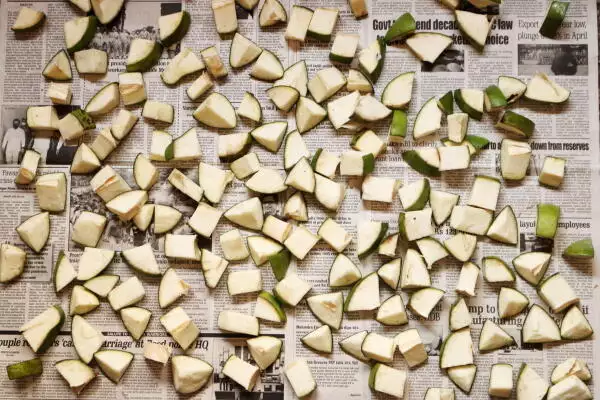

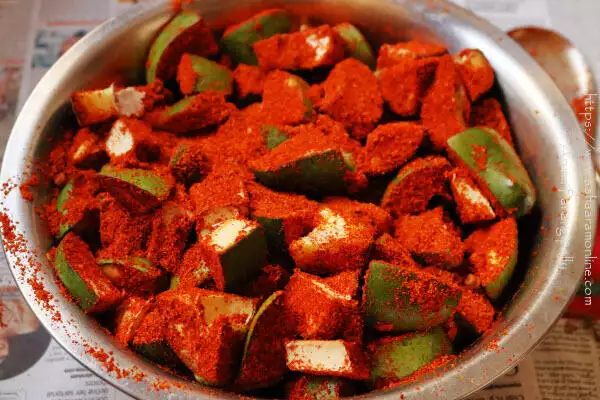
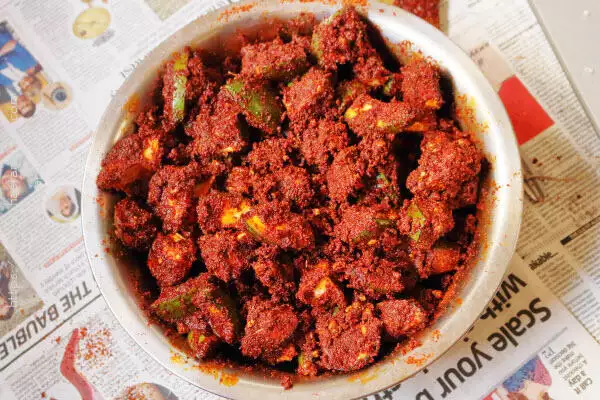

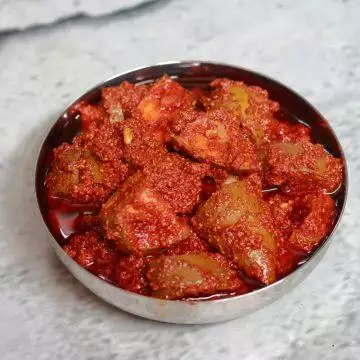

The whole story behind avakai making is very interesting. Andhra is famous for the hot, spicy pickles. I remember once eating avakai in a restaurant in Hyderabad and I had to fan my tongue and run around doing everything to cool it. This pickle is drool worthy and a drop of it would help anyone finish a heap of rice!
Mouth watering ! I will definitely try this. Thanks for the recipe.
I am so excited to have found your beautiful blog. One desire for 2014 I have is to really understand the element of lacto-fermentation in Indian pickle and chutneys and I think you are going to be my guide! So thank you!
Aruna — I just found this recipe when I googled ‘avakai’. You were on top! Thanks Google! Anyway, great tip about including the kernel in each.
Let me know how it turns out, Aneela. In my recipe the proportion of Masala to Mango is relatively high. This is because we often want only the “oota” (pickled masala) as accompaniment. If I don’t make it this way then we are always rooting around for masala. 🙂
endu avakai recipe: cut raw mango pieces each of 1 inch size , mix all these pieces in salt and dry the mango pieces for 2 days in sun , Fry RAI (avalu) and Methi (mentulu) and powder them add red chili powder and mix them in equal quantities , add asfotodia(Inguva podi) also to the mixture and after 2 days of drying the mango pieces, and then mix these mango pieces with required amount of sesam oil(nuvvula nune) which is sufficient for the powder and the mango pieces to submerge in the bottle you put it in. Thats it endu avakai is ready 🙂
Recipe by:
Bhanu kiran (hyderabad)
Thank you, Bhanu. 🙂
yumm!!!!!
Aruna,
You have quite a collection of recipes! Thoroughly enjoying discovering different recipes here and your description of the Avakai making process. Who doesn’t like Avakai anyway?! 🙂
What is the solution if aavakaya tastes salty
How salty is it? The only solution is to increase ava-podi and kharam.
Great Recipe Aruna.I finally found an avakai recipe with measurements in weight. Can we powder and add the menthulu ? will the whole seeds take time to soak and also add bitterness ?
Thank you Aditya. The Menthulu soak rather quickly and not bitter after 2 weeks.
Don’t powder them, that will change taste. Leave them out.
I meant Menthulu pickle rather quickly.
amazing recipe…just one question do we need to heat oil and how much time….and for mustard powder we need to grind the whole mustard the black one that we use daily right?
Hello Nisha,
Just heat the oil till its hot (not smoking) and let it cool completely. I do this the previous evening to ensure it is absolutely cool and there is no danger of any condensation. Do not cover it as it cools.
Yes, regular mustard ground to a coarse powder.
Pickle looks mouthwatering Aruna. Bookmarking it. Loved the colour. I can feel the tongue tickling taste.
Our pickle is little more spicy , i gusee we put more mustard powder , how can we fix it?
Ava podi ghatu ekkuva unda, kharam ekkuva unda? The mustard taste will settle after it pickles (Oorey-ka) for about 1 month. If you still think that is overpowering, and don’t want more spiciness, add some kashmiri red chilli powder (or any chilli powder which is not spicy) plus oil and salt as needed. I would recommend that you wait because the taste does settle after a few weeks.
Awesome thanks
Please share the recipie for mango pickle using jaggery
Wonderful and detailed post with useful hints and tips about avakkai.
A perfect blend of ingredients could bring the taste of real avakai, today I have read it here in your process of explanation about avakai pickle. Thank you aaharam online team for the best and true explanation.